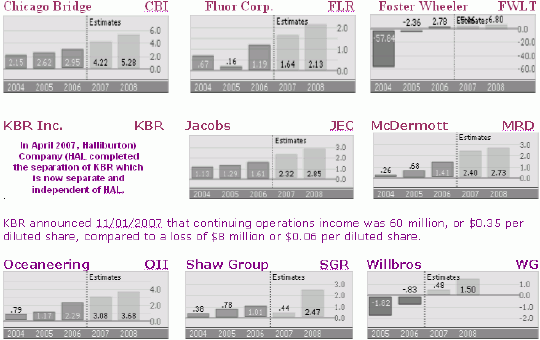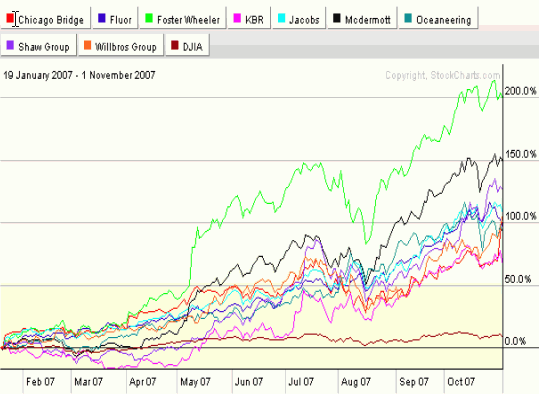ABOUT: The following Oil & Gas Industry report is provided by guest author Robert Williams, PhD, P.E., and industry executive with over 40 years experience working for major oil corporations as well as smaller companies all across the globe. Robert has extensive petroleum, water and electrical industries experience regarding Supervisory Control and Data Acquisition (SCADA) systems, Management Information Systems (MIS/IT), Distributed Control Systems fire & gas/emergency shutdown systems, instrumentation, metering, communications, security/CCTV and electrical engineering on such major projects as Shell Bonga FPSO, Saudi Strategic Storage Project, Libyan Water Pipeline, Trans Alaska crude oil pipeline, Alaska Natural Gas Transportation System, Occidental Piper B and Saltire offshore platforms and many other worldwide projects.
::::::::::::::::::::::::::::::::::::::::::
Oil & Gas Industry Perspective Part II (Offshore)
by Robert Williams, PhD, P.E.
See Part I – Oil & Gas Engineering
The major oil supplier areas of the world are Middle East (specifically Saudi Arabia), West/North Africa, Russia, Venezuela, Mexico, Indonesia and including the North American suppliers and consumers, USA and Canada. Major oil consumers are USA/Canada, Europe, Japan, China, India/S.E. Asia and Australia/New Zealand.
The crude oil process of converting to automobile gasoline involves finding the oil or gas by seismic surveys, drilling and extracting, producing and transporting crude oil. Crude oil may be refined at the supplier’s origin country and the petroleum products exported or the crude oil is transported for refining in the consumer country. Natural gas is pipelined to consumers otherwise it has to be transported as liquefied natural gas (LNG) tankers.
Oil and gas industry capital expenditures include exploration permits from national governments, seismic surveys, either buying or leasing drilling rigs, onshore/offshore processing facilities, crude oil/products pipelines and/or tankers including loading and offloading port facilities, crude oil/products storage terminals, fuel truck loading racks and gasoline stations.
These industry perspectives are designed to identify companies actively involved in all of the oil/gas industry aspects and specifically highlight those for potential investment on a long or mid-term basis. There are many companies who are industry leaders and there are others that have established a niche in these industries Their charts will be provided to identify possible long trades. No speculation will be made as to short or options trades in these companies. The first Industry Perspective highlighted oil/gas engineering companies whereas this Industry Perspective will focus on offshore crude oil exploration and production.
Finding and producing oil and natural gas deposits, converting these into petroleum products and transporting them to market makes the oil/gas industry the most international of all industries. Many offshore production and supplier companies are exchange listed in London, Oslo, Amsterdam or other exchanges, including Australia. These companies have not been identified in this Industry Perspective No. 2. Please contact author at riwilliams1@cox.net if you have international trading access and wish to know more about these companies.
Industry Perspectives
1. Maintained high crude oil prices are initiating new and old exploration fields to be developed. For example, Chile has just announced exploration and production contracts for new onshore development fields.
2. Driven by increased demand in China and India, Asia is now the largest consumer of oil products.
3. The production of oil and gas reserves is increasingly moving to remote, challenging locations, such as Russia’s Sakhalin Island, offshore West Africa (Angola, Nigeria, etc.), and Canadian arctic and deep or ultra deep offshore locations including the Gulf of Mexico.
4. A major oil company has made a new oil discovery in the ultra-deep offshore West African coast in water depths of approximately 6000 feet. Ultra-deep is an industry term which especially applies to the Gulf of Mexico where oil exploration and new discoveries are at depths of up to10,000 feet.
5. Anadarko Petroleum (APC) has made an oil discovery at its West Tonga prospect in the deepwater Gulf of Mexico. The discovery well, located in approximately 4,700 feet of water, was drilled to a total depth of 25,680 feet. The well was drilled by Diamond Offshore’s (DO) semi-submersible, Ocean Valiant. (Source: Rigzone 12/05/2007)
6. Chevron and Massachusetts Institute of Technology announced an energy research program to develop remote, ultra-deepwater exploration and production technology. The $5 million Chevron Remote and Ultra-Deepwater Research Program will focus on developing the technologies required to access hydrocarbons in water depths up to 10,000 feet in a safe, cost effective and environmentally friendly manner. (Source: Rigzone Newsletter)
7. Mexico’s national oil company (Pemex) has only nine years of proven oil reserves at current production rates, and the company is hoping to find new deposits in deeper waters of the Gulf to compensate for declining output at its traditional areas. Pemex plans to begin producing oil at deep water projects in 2014.
8. China’s electricity consumption has exceeded planned expectations to the extent that is affects reliability, i.e. shortages and many parts of China have electricity rationing programs. World Bank projections are for a doubling of energy consumption from 2000 to 2020. China are building a semi-submersible capable of deep and ultra-deep drilling for their offshore fields which is part of their long range planning to alleviate their dependence on imported crude oil.
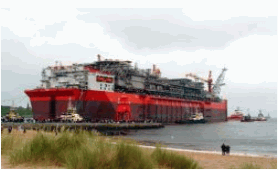 9. The Shell Bonga field, offshore Nigeria, required a complex and extensive subsea system to extract the crude oil from 3000 feet deep water. Production facilities comprise one of the world’s largest Floating Production, Storage and Offloading vessels (FPSO) and deepwater subsea infrastructure. Author was onboard the Bonga during topsides assembly, prior to sailing to Nigeria, and can wholeheartedly verify its size. An FPSO is effectively a 2 million barrel stationary tanker with an offshore production platform on its deck.
9. The Shell Bonga field, offshore Nigeria, required a complex and extensive subsea system to extract the crude oil from 3000 feet deep water. Production facilities comprise one of the world’s largest Floating Production, Storage and Offloading vessels (FPSO) and deepwater subsea infrastructure. Author was onboard the Bonga during topsides assembly, prior to sailing to Nigeria, and can wholeheartedly verify its size. An FPSO is effectively a 2 million barrel stationary tanker with an offshore production platform on its deck.
10. Bonga subsea well clusters were drilled and completed from a mobile drilling unit and connected to the centrally located FPSO by production flowlines, risers and control umbilicals. The project’s estimated recoverable resources add up to more than 600 million barrels of oil. Production began in November 2005 and the current production is 225,000 barrels of oil and 150 million standard cubic feet of gas per day. Crude oil is offloaded onto tankers and gas is pipelined to onshore facilities. Field development costs were approximately $3.5 billion and the initial exploration contract was agreed in 1993. Source: Royal Dutch Shell (RDS)
11. An umbilical is an assembly of hydraulic hoses which can also include electrical and/or fiber optic cables used to control subsea structures from a platform or a surface vessel. A Riser is a pipe or assembly of pipes used to transfer produced fluids from the seabed to the surface facilities or to transfer injection fluids, control fluids or lift gas from the surface facilities to the seabed.
12. Offshore fixed platforms have been the norm for continental shelf oil/gas drilling and production; tension leg platforms are used to 3,000 feet water depths and floating production facilities are used for deeper waters. A Tension Leg Platform is a floating production unit anchored to the seabed by taut vertical cables, which considerably restrict its heave motion, making it possible to have the wellheads on the platform.
13. A semi-submersible is a floating drilling vessel that is supported primarily on large pontoon-like structures submerged below the sea surface. The operating decks are elevated above the pontoons on large steel columns. This design minimizes loading from waves and wind. Semi-submersibles can operate in a wide range of water depths, including deep water. They are usually anchored with six to twelve anchors tethered by strong chains and wire cables, which are computer controlled to maintain the semi submersible at the programmed location.
14. In ultra deepwater, riser systems become a technical challenge and a major part of the field development costs. Large external pressures in these great depths cause flexible solutions to run into weight and cost problems.
Major Oil/Gas Companies
Exxon Mobil Corporation (XOM); BP (BP) Chevron Corp. (CVX); Conoco Phillips (COP); Occidental Petroleum Corporation (OXY); Marathon Oil Corporation (MRO); Anadarko Petroleum Corporation (APC) are some of the international oil and gas companies involved in the exploration and production of crude oil and natural gas; the manufacture of petroleum products, and the transportation and sale of crude oil, natural gas and petroleum products. APC is a oil and gas exploration and production company whose major areas of operations are located in the United States, the deepwater of the Gulf of Mexico and Algeria. Anadarko also has production in China, Venezuela and Qatar, a development project in Brazil and is executing exploration programs in several other countries.
Independent Oil/Gas Companies
Apache Corp. (APA); Devon Energy Corporation (DYN); Murphy Oil Corporation (MUR) are independent energy companies that explore for, develop and produce natural gas, crude oil and natural gas liquids. APA’s exploration and production interests are focused in the Gulf of Mexico, the Gulf Coast, East Texas, the Permian Basin, the Anadarko Basin and the Western Sedimentary Basin of Canada. It has interests in onshore Egypt, offshore Western Australia, offshore the United Kingdom in the North Sea (North Sea), and onshore Argentina. DYN owns oil and gas properties principally in the United States and Canada and, to a lesser degree, regions located outside North America, including Azerbaijan, Brazil and China. Murphy’s exploration and production include the United States, Canada, the United Kingdom, Ecuador, Malaysia and all other countries.
Oil/Gas Offshore Services Companies
Transocean Inc. (RIG) is an international provider of offshore contract drilling services for oil and gas wells. RIG owns or operates 89 mobile offshore and barge drilling units. Its fleet included 32 high-specification semi-submersibles and drill-ships, 20 other floaters, 25 jack-ups and four other rigs as of February 2, 2007. RIG’s primary business is to contract these drilling rigs, related equipment and work crews primarily on a dayrate basis to drill oil and gas wells.
Diamond Offshore Drilling, Inc. (DO) provides contract drilling services to the energy industry worldwide and is also engaged in deepwater drilling with a fleet of 44 offshore drilling rigs. The Company’s fleet consists of 30 semi-submersibles, 13 jack-ups and one drill-ship. The Company offers a range of services worldwide in various markets, including the deep water, harsh environment, conventional semi-submersible and jack-up markets. The Company provides offshore drilling services to a customer base that includes independent oil and gas companies and government-owned oil companies.
Schlumberger Limited (SLB) is an oilfield services company supplying a range of technology services and solutions to the international oil and gas industry. SLB subsidiary WesternGeco is an advanced surface seismic company. SLB’s products and services include the evaluation and development of oil reservoirs (controlled digging, pumping and testing services), well construction and production consulting, and sale of software programs. The Company also offers storage tank and seismic monitoring services.
Halliburton Company (HAL) provides a variety of services, products, maintenance, engineering and construction to energy, industrial, and governmental customers. Its six business segments are: Production Optimization, Fluid Systems, Drilling and Formation Evaluation, Digital and Consulting Solutions, Energy and Chemicals, and Government and Infrastructure. It refers to the combination of Production Optimization, Fluid Systems, Drilling and Formation Evaluation, and Digital and Consulting Solutions segments as its Energy Services Group (ESG).
Flowserve Corporation (FLS) is a manufacturer and aftermarket service provider of flow control systems. The Company develops and manufactures precision-engineered flow control equipment, such as pumps, valves and seals, for critical service applications. It produces industrial pumps, industrial valves, control valves, nuclear valves, valve actuators and precision mechanical seals, and provides a range of related flow management services worldwide, primarily for the process industries.
Some companies involved with deep sea oil/gas developments have significant earnings projections.
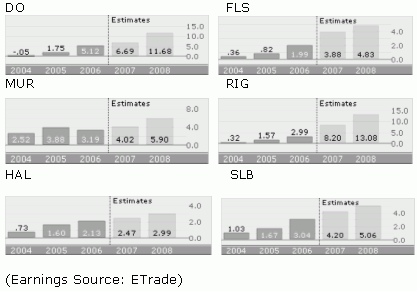
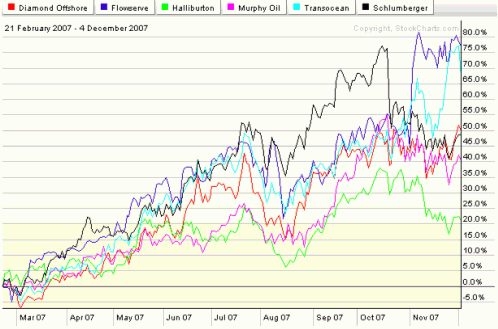
Summary
The oil/gas companies combined performance charts (see chart) indicates a general uptrend and are all indicating increasing earnings. Please note that recent markets declines do affect these companies’ stock pricing but may very well provide excellent entry points depending on your market timing criteria.
The world is continuously expanding both crude oil consumption and development of new crude oil sources. See the next Industry Perspective for oil/gas projections to 2030.
——
If you have questions or comments for Robert regarding this report or the oil industry, you may submit them here at the blog using the comments form or click "Contact" above to submit and I will forward those on.
Disclaimer: The author Rober Williams, currently has no positions in the companies above. I do have a long position in Transocean (RIG).
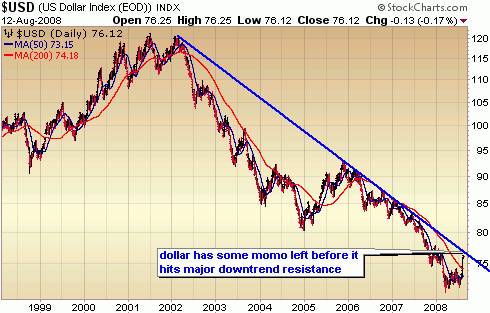
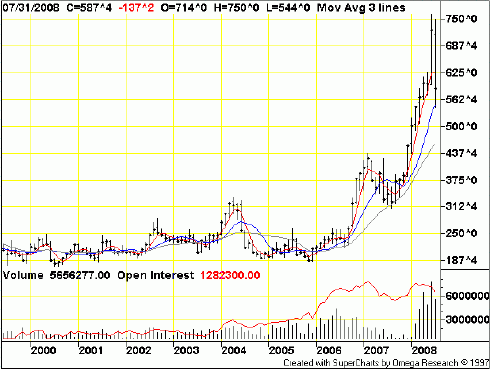
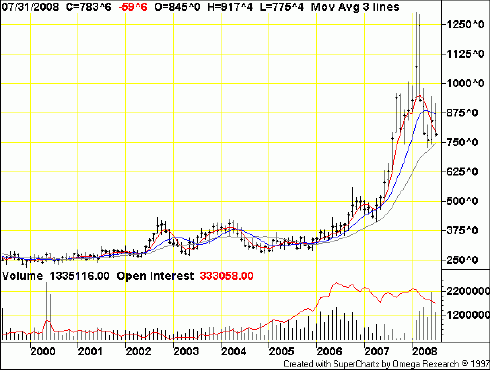
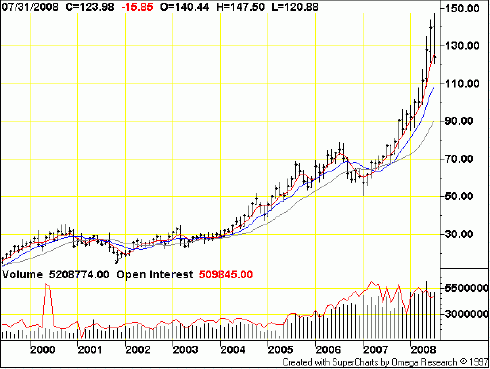
 CEO (CNOOC Ltd.) is an independent offshore oil and gas exploration and production company with four offshore China production areas namely, Bohai Bay, Eastern, Western and Southern South China Sea. CEO is an offshore producer in Indonesia, Australia and Africa. In 2006 CEO acquired offshore licenses in Nigeria. Market Capitalization is $67,120 millions with estimated P/E of 16.7.
CEO (CNOOC Ltd.) is an independent offshore oil and gas exploration and production company with four offshore China production areas namely, Bohai Bay, Eastern, Western and Southern South China Sea. CEO is an offshore producer in Indonesia, Australia and Africa. In 2006 CEO acquired offshore licenses in Nigeria. Market Capitalization is $67,120 millions with estimated P/E of 16.7. PTR (PetroChina Ltd.) activities include petroleum and natural gas within four business segments; 1) Exploration and Production, 2) Refining and Marketing, 3) Chemicals and Marketing, and 4) Natural Gas and Pipelines. PTR was established as a joint stock company as part of the restructuring of the China National Petroleum Corp. (CNPC). CNPC is the controlling shareholder of PTR with 88.21% shares. Market Capitalization is $274,350 millions with estimated P/E of 13.9.
PTR (PetroChina Ltd.) activities include petroleum and natural gas within four business segments; 1) Exploration and Production, 2) Refining and Marketing, 3) Chemicals and Marketing, and 4) Natural Gas and Pipelines. PTR was established as a joint stock company as part of the restructuring of the China National Petroleum Corp. (CNPC). CNPC is the controlling shareholder of PTR with 88.21% shares. Market Capitalization is $274,350 millions with estimated P/E of 13.9. SNP (China Petroleum & Chemical Co.) is an integrated oil, gas and chemical company with operating segments for exploration, production, refining, marketing, distribution and chemical manufacturing/distribution. Market Capitalization is $98,477 millions with estimated P/E of 12.4. SNP was setup in February, 2000 by China Petrochemical Corporation as the sole initiator, pursuant to the Company Law of the People’s Republic of China. SNP issued 16.78 billion H shares in Hong Kong, New York and London in October, 2000. The Company floated 2.8 billion A shares in Shanghai in July 2001. As of end 2006, The Company’s total number of shares was 86.7 billion, of which 75.84% was held by the State through Sinopec Group, 19.35% by H share holders and 4.81% by investors in China. SNP website provides stock quotations for all exchanges they are listed on. CEO, PTR and SNP company names above are hyperlinked to each company’s website. [A shares are principally for mainland China; H shares are listed on Hong Kong, New York and London]
SNP (China Petroleum & Chemical Co.) is an integrated oil, gas and chemical company with operating segments for exploration, production, refining, marketing, distribution and chemical manufacturing/distribution. Market Capitalization is $98,477 millions with estimated P/E of 12.4. SNP was setup in February, 2000 by China Petrochemical Corporation as the sole initiator, pursuant to the Company Law of the People’s Republic of China. SNP issued 16.78 billion H shares in Hong Kong, New York and London in October, 2000. The Company floated 2.8 billion A shares in Shanghai in July 2001. As of end 2006, The Company’s total number of shares was 86.7 billion, of which 75.84% was held by the State through Sinopec Group, 19.35% by H share holders and 4.81% by investors in China. SNP website provides stock quotations for all exchanges they are listed on. CEO, PTR and SNP company names above are hyperlinked to each company’s website. [A shares are principally for mainland China; H shares are listed on Hong Kong, New York and London]
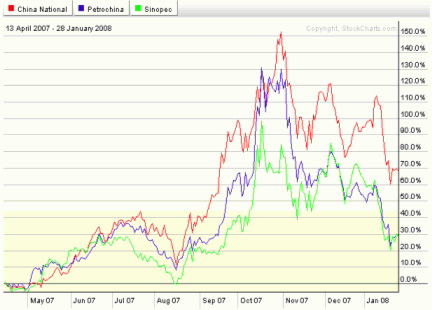
 A non-financial recommendation to those would-be Great Wall visitors is to use the cable car (see ticket thumbnail photo) which will not stress your calf muscles since portions of the wall are very steep, without steps, and easier traversed
A non-financial recommendation to those would-be Great Wall visitors is to use the cable car (see ticket thumbnail photo) which will not stress your calf muscles since portions of the wall are very steep, without steps, and easier traversed 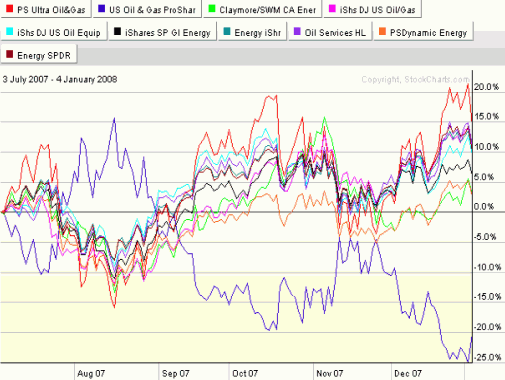
 9. The Shell Bonga field, offshore Nigeria, required a complex and extensive subsea system to extract the crude oil from 3000 feet deep water. Production facilities comprise one of the world’s largest Floating Production, Storage and Offloading vessels (FPSO) and deepwater subsea infrastructure. Author was onboard the Bonga during topsides assembly, prior to sailing to Nigeria, and can wholeheartedly verify its size. An FPSO is effectively a 2 million barrel stationary tanker with an offshore production platform on its deck.
9. The Shell Bonga field, offshore Nigeria, required a complex and extensive subsea system to extract the crude oil from 3000 feet deep water. Production facilities comprise one of the world’s largest Floating Production, Storage and Offloading vessels (FPSO) and deepwater subsea infrastructure. Author was onboard the Bonga during topsides assembly, prior to sailing to Nigeria, and can wholeheartedly verify its size. An FPSO is effectively a 2 million barrel stationary tanker with an offshore production platform on its deck. 

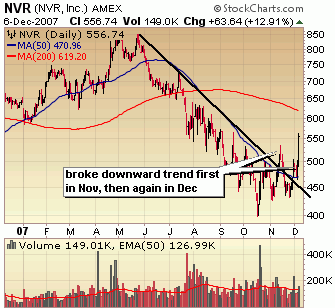
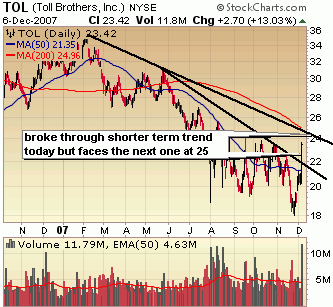
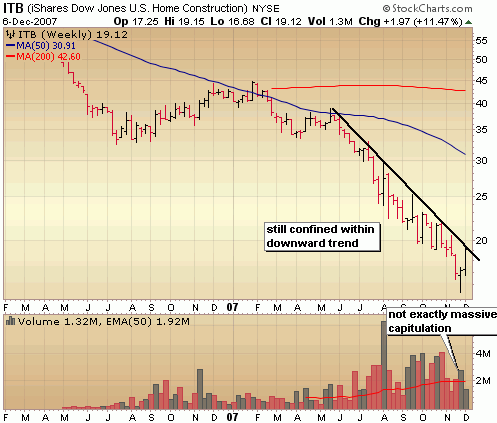
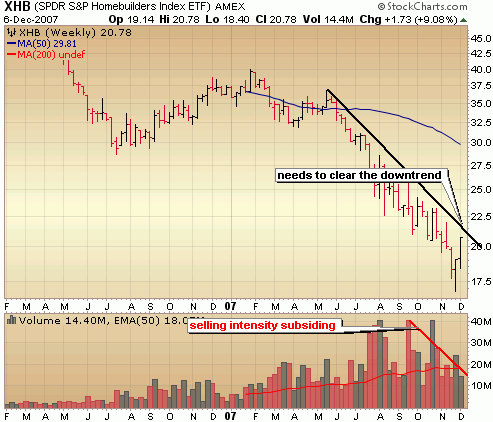
 It takes the top spot because of the big CEO insider buying, best technicals and the fact that the company has remained profitable in every quarter during this housing crash and is expected to remain so. CEO Dwight Schar has also been through a meltdown before, nearly bankrupting NVR several years ago. I’m sure he’s smart enough to learn from those mistakes. The second time around, Schar avoided the risky land investments and went with an approach called optioning where the builder makes a small down payment for the option of purchasing the plot of land in the future. Only when the contract is signed on the sale does NVR purchase the land and build the home. It’s a common practice among home builders now, but apparently NVR has done a better job of not over purchasing land.
It takes the top spot because of the big CEO insider buying, best technicals and the fact that the company has remained profitable in every quarter during this housing crash and is expected to remain so. CEO Dwight Schar has also been through a meltdown before, nearly bankrupting NVR several years ago. I’m sure he’s smart enough to learn from those mistakes. The second time around, Schar avoided the risky land investments and went with an approach called optioning where the builder makes a small down payment for the option of purchasing the plot of land in the future. Only when the contract is signed on the sale does NVR purchase the land and build the home. It’s a common practice among home builders now, but apparently NVR has done a better job of not over purchasing land.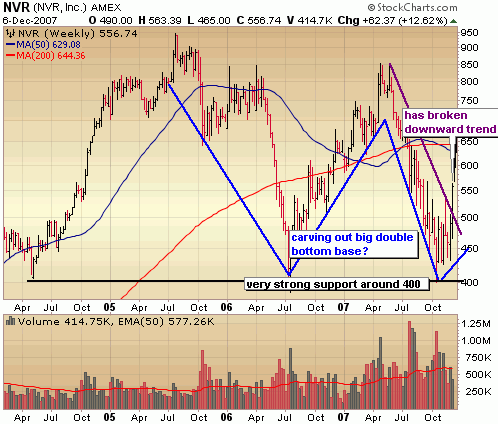
 Like NVR, TOL recently tested an important level of support at 19 (a level it found support at back in 2004 as well) and bounced. Yes, there is some room to run to the upside but I wouldn’t be chasing it. Once the euphoria of the subprime rate freeze and looming Fed rate cuts wears off, home builders should pull back and offer a much better entry. Just how much is anyone’s guess, but keep an eye on on resistance above from the long downward trend line (in blue) and support at the bottom around 19. Price should continue to get squeezed between those two points over the next several weeks creating a big triangle formation. This will be the moment of truth for TOL. A break up out this formation indicates the likelihood of a long term bottom while a break down below 19 indicates further deterioration ahead, possibly to the next level of support around 16.
Like NVR, TOL recently tested an important level of support at 19 (a level it found support at back in 2004 as well) and bounced. Yes, there is some room to run to the upside but I wouldn’t be chasing it. Once the euphoria of the subprime rate freeze and looming Fed rate cuts wears off, home builders should pull back and offer a much better entry. Just how much is anyone’s guess, but keep an eye on on resistance above from the long downward trend line (in blue) and support at the bottom around 19. Price should continue to get squeezed between those two points over the next several weeks creating a big triangle formation. This will be the moment of truth for TOL. A break up out this formation indicates the likelihood of a long term bottom while a break down below 19 indicates further deterioration ahead, possibly to the next level of support around 16. 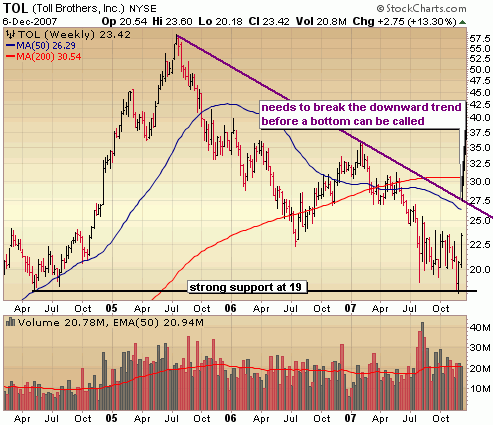
 This is the inauguration issue of the Oil & Gas Industry Perspective published with the express purpose of keeping you abreast of industry trends and developments and to potentially identify investment opportunities. Industry sectors involved are the Integrated Companies, Services and Equipment Companies and Operations Companies. All these industry sector companies are involved with future developments capital expenditures either for exploration, production, distribution or for technological advancements. Not included in these Oil/Gas industry sectors is one industry which is highly involved with oil and gas developments. This industry is the engineering companies that are listed under engineering because many are also diversified into environmental, power, federal government, pharmaceuticals, nuclear and life sciences engineering projects.
This is the inauguration issue of the Oil & Gas Industry Perspective published with the express purpose of keeping you abreast of industry trends and developments and to potentially identify investment opportunities. Industry sectors involved are the Integrated Companies, Services and Equipment Companies and Operations Companies. All these industry sector companies are involved with future developments capital expenditures either for exploration, production, distribution or for technological advancements. Not included in these Oil/Gas industry sectors is one industry which is highly involved with oil and gas developments. This industry is the engineering companies that are listed under engineering because many are also diversified into environmental, power, federal government, pharmaceuticals, nuclear and life sciences engineering projects. 